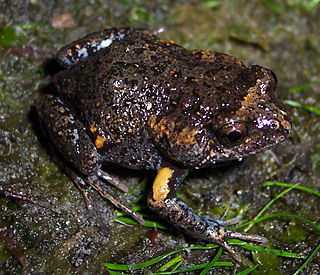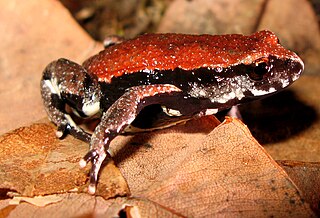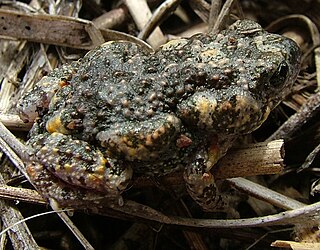
The Kimberley is the northernmost of the nine regions of Western Australia. It is bordered on the west by the Indian Ocean, on the north by the Timor Sea, on the south by the Great Sandy and Tanami deserts in the region of the Pilbara, and on the east by the Northern Territory.

Uperoleia is a genus of frogs in the family Myobatrachidae. They are native to northern and eastern Australia and southern lowlands of New Guinea. These are small squat frogs, more commonly known as "toadlets". They have glandular skin, often with a pair of raised glands behind each eye, or on the flanks.

The Bibron's toadlet or brown toadlet is a species of Australian ground-dwelling frog that, although having declined over much of its range, is widespread through most of New South Wales, Victoria, south-eastern Queensland and eastern South Australia, including Kangaroo Island.

The Red-backed Toadlet is a species of ground frog native to the coast and adjacent ranges of eastern Australia, from just north of Sydney to South-eastern Queensland.

The smooth toadlet is a species of Australian ground-dwelling frog native to the coast and west of the ranges of south-east Queensland, all of eastern New South Wales and north-eastern Victoria.

The dusky toadlet is a species of Australian ground-dwelling frog that inhabits coastal areas from just north of Sydney, New South Wales to mid-northern Queensland.

Tyler's toadlet is a species of ground frog that is found in coastal areas in southern New South Wales and eastern Victoria.

The wrinkled toadlet is a species of small, ground-dwelling frog in the family Myobatrachidae It is endemic to Australia. It is also commonly called the small-headed toadlet, red-groined toadlet or the chubby gungan.

Eric Georg Mjöberg was a Swedish zoologist and ethnographer who led the first Swedish scientific expeditions to Australia in the early 1900s, and worked in Indonesia. The plant Vaccinium mjoebergii J.J.Sm. was named after him, as were Mjoberg's toadlet, the grasshopper Goniaea mjoebergi, the crab Uca mjoebergi, Mjöberg's forest dragon, the Atherton Tableland skink, Mjöberg's bush frog, and Mjöberg's dwarf litter frog.
The Derby toadlet is a species of frog in the family Myobatrachidae. It is endemic to the Kimberley region near Derby and Broome in Western Australia. Its natural habitats are subtropical or tropical dry lowland grassland and intermittent freshwater marshes.
The fat toadlet is a species of frog in the family Myobatrachidae. It is endemic to Australia. Its natural habitats are subtropical or tropical dry lowland grassland and intermittent freshwater marshes.
The Martin's toadlet is a species of frog in the family Myobatrachidae. It is endemic to south-eastern Australia.
Mjoberg's toadlet is a species of frog in the family Myobatrachidae. It is endemic to Australia. Its natural habitats are subtropical or tropical dry shrubland and subtropical or tropical dry lowland grassland. It is named for Swedish zoologist Eric Mjöberg.
The Russell's toadlet is a species of frog in the family Myobatrachidae. It is endemic to Australia. Its natural habitats are subtropical or tropical dry lowland grassland, intermittent rivers, freshwater marshes, intermittent freshwater marshes, and canals and ditches.
The mole toadlet is a species of frog in the family Myobatrachidae. It is endemic to Western Australia. Its natural habitats are dry savanna and subtropical or tropical dry lowland grassland.

The Kimberley tropical savanna is a tropical and subtropical grasslands, savannas, and shrublands ecoregion in northwestern Australia, covering portions of Western Australia and the Northern Territory south of the Timor Sea.
The tiny Pilbara toadlet ) is a species of frog in the family Myobatrachidae. It is endemic to the arid Pilbara region of Australia. It is a burrowing frog and is found in rocky gorges and creeks in the Pilbara following cyclonic rains. The species name saxatilis means "rock-dwelling".
Margaret Davies is an Australian herpetologist born on 8 November 1944. She worked at the University of Adelaide studying Australian frogs, retiring in 2002. Initially appointed to a teaching post at the university, she was inspired to research frog taxonomy and their ecology from the 1970s. She identified over 30 new species of frogs during her career. She has contributed to over 120 publications.










